Totally Unnamed Gaming Column - Attack it's weak point for maximum damage!
by Mutsuki,

|
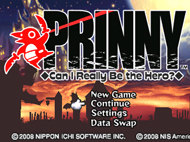
|

|
|

|
|
 | |
Welcome to another week of the Unnamed Gaming column, and as always, more games for your pleasure today.
As we promised last week, we have a selection of games to look at from across the oceans, ranging from a platformer involving walking explosives from the Disgaea world, a visual novel with rhythm elements, the latest offering from the creators of Guilty Gear, and an opportunity to take a peek at a game which encourages you to create your own explosives.
Remember that all the games that are reviewed here are up for grabs if you can help us name our column, and the competition will close on the 31st of October. Remember to e-mail [email protected] (jon at animenewsnetwork.com.au?subject=Name%20the%20Column%20Competition), remembering one entry per person.
Shall we get going?
[Zuiko] PSP: Prinny: Can I really be the hero? (Nippon Ichi Software)

|
|

|

|
| Probable Rating | PG (Mild Violence) |
| Release Date | 23/02/2009 |
| # of Players | 1 |
| Availability | Import: Common |
| Language | English |
| Fluency/Literacy Level | Basic |
Hey, let's go Dood!
Back in 2003, a little game known as Disgaea graced our Playstations. Fast forward a couple of sequels and now Nippon Ichi Software has brought us its new spinoff in the form of “Prinny: Can I really be the hero?” for the Playstation Portable. Adopting a 2D Side scrolling Adventure style while still retaining the same humor from its main series, do the Prinnys stand a chance or should they all join the doods back in the netherworld?
Acting as the basis premise to the game, the story sets you in the role of a Prinny, a small pouch wearing Penguin like creature who serves as common servants or enemies in the main Disgaea games. You start off being forced with making an Ultra dessert for Etna who assigns the 1000 Prinny squad 10 hours to get the job done. Etna then tells them to create the dessert for her, else she'll kill them all off in one fair swoop. The story is very light, rich in comedy and never takes itself seriously, which is good given its context and the humor element is definitely what makes this game so fun and addicting to play. The story spans for about 2-3 hours assuming that you don't retry or replay boss battles, otherwise it can extend to at least 8 hours easily on normal.
The game lets you assume control of one Prinny at a time, traversing one of over 7 different levels all connected to a small hub in which you initially reside. The Hub world, Prinny's little town, is basically your network to all the levels and also contains other characters which give you progress updates and allow you to save. Each of the levels are split up into checkpoints which make dying and restarting less painful. Exiting a level midway however doesn't save your progress, requiring you to start the level all the way at the beginning again regardless of whatever checkpoint you reached before.
Inside each segment is a variety of different enemies and obstacles to overcome. At the end of each level is a boss fight and this is where some of the most memorable fights occur. The bosses are all very unique in style and manner of attacking and usually require a lot of thought in how to beat each one. Usually this involves whittling away at a boss's health meter and possibly stunning them. If you mess up in any part of the levels or bosses, each Prinny comes equipped with a self destruct feature via a button combination – this instantly blow themselves up and send you back to your last checkpoint or to restart the boss fights.
Your Prinny doesn't come to the adventure empty handed as they are equipped with their trusty blades to help them finish the job. Prinny can attack normally; perform a Jump attack which launches beams with every swipe in the air and a hip thrust which allows the Prinny to temporarily stun enemies. Though there is a limited set of attack moves, there never is any major need for more as it is sufficient as is.
The only issue is the controls, especially when you jump – it becomes imprecise as you have no air control while jumping, but this is usually standard in most 2D Platformers nowadays. The hip thrust also has a slight delay requiring precise timing to perform it effectively. This can lead to far too many unnecessary deaths and restarts as what you want your Prinny to do, may not be exactly what occurs on the screen.
Take it from me now, this game is very difficult and pulls no punches to tell you that. Given the fact that you essentially have 1000 lives to go through and each one of these can take damage 3 times before dying on normal or one hit instant death on hard mode, you'll eventually be going through lives like cotton candy. The end bosses are also no slouch, as they all vary in the method you use to take each one down. Take this as an example, in my play through, just getting to the end of the 3rd level; I had already gone through 113 Prinnies.
Not only that, each level, regardless of order, will ramp up in difficulty as you select them, affecting which enemies appear in the stage, including the end boss. This heightened level of difficulty will definitely be what breaks the game for some people while others who crave these types of games will enjoy the satisfaction of managing to finish each of the levels. Though there are 1000 Prinnys, you only get to control one at a time. As you are in essence, controlling a different Prinny each time you die, there never is any personality that is distinct to one Prinny or another as they all talk and act in the same manner and by the end of it, you'll be adding “dood” to the end of your sentences too.
Once you have played through the main story, there are a number of additional extras to unlock such as an alternate storyline, secret endings and a New game+. To add to this, If you connect to the PSN store, you may be able to download extra levels
Visually the game uses 2D character sprites coupled with 3D backgrounds which all give off a visual style that complements the game's unique sense of humor. It is s testament to say that each Prinny has a distinct charm to them that will keep you hooked. The voice work is also very good and you'll definitely chuckle here and there listening to the Prinnys as they banter to each other or die a terrible death.
For you importers, the game is fully voiced and translated in English so there should be no problems in understanding the game, and the PSP has no region locks for playing game UMDs. NIS has also added a couple of additional material which comes in the package for those who manage to obtain the premium box purchased from Rosenqueen, the NIS America online store. For you lucky ones, you will find a soundtrack CD featuring 20 songs from the game with included Japanese and English lyric sheets and a penny arcade comic insert included with a copy of the game itself. Just to note, the game is also available in PAL format in the UK.
“Prinny: Can I really be the hero?” is a fun title and should definitely be played by any fan of the Disgaea series or anyone into traditional 2D Side Scrollers. Just beware of the high difficulty curve and old style controls, and you should enjoy picking up this title.
[Zuiko] PSP: Solfege: Sweet Harmony (GungHo)

|
|
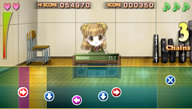
|
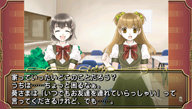
|
| Probable Rating | M (Romantic Themes) |
| Release Date | 16/12/2008 |
| # of Players | 1 |
| Availability | Import: Common |
| Language | Japanese |
| Fluency/Literacy Level | Advanced: Hiragana/Katakana/Kanji |
| Notes | Contains Yuri Undertones |
With Visual Novels being extremely commonplace in the Japanese gaming market, there are a growing number of titles being ported over from their PC counterparts on to next gen consoles. Many of these titles are simply pick-your-own-path novels with very little else in terms of gameplay mechanics. Contrary to this comes Kogado Studio teaming up with Gungho to deliver Solfege ~Sweet Harmony~ for the Playstation portable. Gungho is known for rereleasing a variety of visual novels onto console and handhelds but what sets Solfege apart from the rest is its unique blend of Visual novel and music game.
Solfege ~Sweet Harmony~ centers on a young high school girl named Kagura returning to the school she had left 3 years prior. Mostly following her day to day life in school, the tale starts off with a flashback to her childhood and her encounter with Sukune, her beloved senpai. Fast forward to the present, Kagura has just returned from being away in a foreign country and she enters a prestigious all girl school. As such, she runs into her dear senpai and from that point forward come a series of twists and complications.
Presented as a heartwarming tale of love and friendship, the narrative has a very slow pacing to it with story segments comprising of over 18 chapters which all seem to play on for long periods. Players be warned however; the game is full of suggestive themes centering on a girl-girl relationship so anyone who might not be fond of that stay clear. The story only has a couple of plot twists which are a bit predictable but there really isn't anything else that will captivate you other than seeing her everyday banter with her classmates.
Eventually, you'll follow the typical pattern of going through dialogue and eventually pausing for the occasional Rhythm game. The story can be completed in about 10 hours and there isn't really much to come back to unless you are after all the multiple paths and scenarios. There is however, a special scenario which can be played through after the main story is completed involving Kagura's interaction with 2 new classmates.
Gameplay is separated into 2 parts, the visual novel and the music game sections. The visual novel portion plays out like your typical visual novel with dialogue boxes and on screen anime style characters. Going through dialogue is simply a matter of pressing Circle multiple times to cycle through them. In addition to this, you can revisit text by pressing Triangle or you can let the game auto play through the conversations by pressing the R shoulder button. Text can also be skipped by pressing L to allow players to quickly go through each scenario path.
While the Novel portion makes up the majority of the game, the Rhythm game portions play out a little bit differently than other games. The notes are presented on a stave with sections segregated in different colors to denote the point value. The buttons are presented as notes which head from left to right requiring you to press the correct button for the corresponding note at a given time.
The timing you use to press the note is the big difference, as you do not need to wait for the note to head to a certain point to hit it. Instead the game adopts a more shooting mechanic where you press a note and a small beam will fly across and hit the note at the position along the stave it is in, giving you that amount of points. The issue is that the game throws you right into the action without much so a single tutorial. If you skipped over the manual like me, you'll find the game much more frustrating to play as treating this as any other music game doesn't let you play properly.
One of the biggest gripe I have about the game is the fact that it constantly recycles certain songs again and again right after each other. This result in very little variety and by the end of it, you'll have a list of songs that you don't ever want to play or hear again. I've played the theme song at least 6 times during my play through and I don't think I want to play that song ever again.
After finishing the game, there is very little to go back to other than collecting the rest of the extras mostly consisting of images and scenes which can be obtained by replaying the story mode and going through other paths. As a music game, the song list is limited to only a few songs which offer poor replay value assuming you didn't get annoyed at playing them over and over during the story mode.
If any of you plan to import the title, first and foremost be warned, the game contains a large amount of text and dialogue and you will definitely need a good grasp of the Japanese language to fully enjoy the entire of the story. Those with limited knowledge of the Japanese language and after the Rhythm portion will find that unlocking all the songs is a painful chore due to the slow pacing and large story segments between each song.
Overall the game offers very little apart from the story and if you don't have a good grasp of Japanese give this one a pass.
[Jacky] PS3: Blazblue: Clamity Trigger (Arc System Works)

|
|

|

|
| Probable Rating | M (Violence) |
| Release Date | 25/06/2009 |
| # of Players | 1-2 |
| Availability | Import: Common |
| Language | English/Japanese |
| Fluency/Literacy Level | Basic: Hiragana/Katakana |
The fighting genre has not really evolved since the introduction of 3D fighters and most fighting franchises have gone for cosmetic changes rather than ones focused on gameplay. BlazBlue - Calamity Trigger is not here to push any envelopes, but rather work on what exists, so it's hard to nail down if the game is worth all the praise it's currently getting.
BlazBlue stays true to traditional sprite based 2D fighters in both presentation and gameplay. The overall presentation of the game from the menus to the primary gameplay is very well polished. The style, art, and character design is very unique - As expected from Arc System Works, the company which brought us the Guilty Gear franchise (and Bridget).
Some superficially noticeable differences which separate this title from the others include, but is not limited to, the move from standard definition 2D sprites to high definition and the use of 3D rendered landscapes against 2D sprites. While some may say that it is nothing new; do not forget that we are dealing with sprites for the character animation - it's a delicate task of visual balance between the second and third dimensions and definitely something which require a lot of skill.
For those who are regulars to the fighting genre will know that BlazBlue is a technical fighter like Guilty Gear. It demands players to chain a good amount of combos to actually make the best of the game. With that said, button mashers will find near to no joy with this title and should look elsewhere.
There are four types of attacks: weak, medium and strong as well as the game's flagship ‘Drive Attack’, unique to each character. Drive attacks implements a variety of elemental statuses and effects which, again, is unique to each character.
For example, Rachel uses the element of wind to her advantage by pulling opponents closer to draw out other combos. Ragna uses vampire-esque moves to drain blood from his opponents effectively draining the enemy's HP while restoring his own. Arkune uses curse-like elements like poison and is a great character for those who like to draw out a longer battle. Role-playing elements in a fighting game sounds great but it is not without quirks.
You would think an offering of only twelve playable characters in a fighting game is a good indication of how much more time the development team would have spent on balancing out these characters. This isn't necessarily true with BlazBlue. Self-proclaimed to have fleshed out the story mode ‘that tells the tales of each character’; it seems like the developers have forgotten to flesh out their characters aside from the cosmetics.
Balancing issues with characters are mostly comprised of a speed over power ratio problem. Jin can let out an endless loop of icicles from his ‘Drive Attack’ rendering opponents defenceless. Tager cannot withstand any opponents that are remotely faster than him. Taokaka (opposite of Tager in terms of speed) can let out lightning fast attacks. Akune can rush out a barrage of its ‘Drive Attack’ to keep its opponents at bay. All this is assuming you are actually executing these attacks properly without button mashing.
While BlazBlue is graphically pleasing to the eyes, it tortures players with a rather repetitive English dub (coupled with combo spammers) and an announcer speaking in English with a Japanese accent that is worth a giggle or two. The game suffers from the developers making up too many fictional terms and at the same time expecting the player or viewer to understand and keep up with all the pseudo-jargon.
Each round starts off with an announcement of ‘The wheel of fate is turning’ and ‘round’ is announced as ‘rebels’. It sounds silly regardless of the explanation in-game. Sadly, you may probably find more understanding of certain words on the BlazBlue Wikipedia entry than in the game's story mode. The good news is players can switch the game back to its original Japanese dub. However, the announcer with the Japanese accent will stay the same.
I have a feeling that a lot of established fanboys of the title will hate me for this review. To the games' credit, it has created such a rabid fanbase in such a short time, which somewhat impresses me. This shows more the superficial character design in video games more specifically catered to an audience with a strong interest in Japanese popular visual culture e.g. Otakus and cosplayers. Fighting game veterans should really give this game a try just because it does pose a good challenge for the unconventional player regardless of all the polish I praised this game for. They say, sex sells... and stereotypical one dimensional male anti-heros sell too.
BlazBlue - Calamity Trigger is currently out in Japan and North America and will not be available in PAL regions until 2010. North American PS3 version works on all regions and can be imported.
[Mutsuki] PS3: Atelier Rorona (Gust)
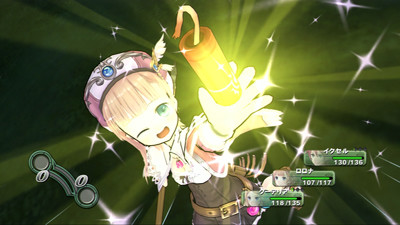
|
|
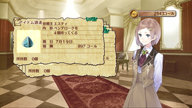
|
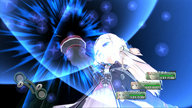
|
| Probable Rating | PG (Mild Violence, Adult Themes) |
| Release Date | 25/06/2009 |
| # of Players | 1 |
| Availability | Import:Common |
| Language | Japanese |
| Fluency/Literacy Level | Expert |
First unveiled in 2009, Developer Gust, known for their Atelier Iris and Ar tonelico series, has yet again crafted a unique style of RPG that is sure to capture the hearts of those who decide to pick up the title.
The first thing to note about Atelier Rorona is that it is mostly a very unique game that the western world has rarely seen previously in the JRPG genre, as it completely focuses on the idea of alchemy, the predecessor to science today.
The closest that anyone has seen previously were the Atelier Iris and the Mana Khemia series. All these games focus on Alchemy, but they do not focus on them as the point which the game revolves around - they rely on outside mystical forces such as Mana to explain their uses and still offer a somewhat classical RPG storyline, of saving the world.
Atelier Rorona differs even from these – The first thing you are told is that you're there to pass your exam to gain your alchemy license, in a world that is more reliant on machinery. No gallivanting across the world to slay some evil overlord or large dragon, or sneaking around dark and creepy dungeons unless you want to.
The art work is very focused, and admittedly really well done, as each of the characters come off as endearing, express what they think and feel through their voice acting and the music almost always fits the bill.
The most interesting aspect of Atelier Rorona is the fact that it's very open. As long as you fulfill the basic requirements of your test, which will change from quarter to quarter, you can do whatever your heart desires as long as you know how to do it in game.
If you're an adventurer, you can go out and become a monster hunter, or if you don't want to fight, you can spend most of your time away from the monsters to pursue more peaceful activities, or you can just get on the couch and take a nap all day.
There's always going to be some items you will need to make yourself, items you have to go out to collect, or monsters to kill, but it's possible to radically adjust what you choose to spend most of your time doing.
The crafting system which Rorona works with is very in-depth, with all ingredients needed to make an item having properties which affect the outcome, as well as the quality and usefulness of the final products.
To spice things up, you can also mix certain properties to create entirely new ones and some of these properties are considered more prevalent than others which can make crafting an exact science to get what you want in an item. Combat itself uses a system where your HP also acts as your source for special attacks – All skills require HP costs, which can mean that throwing out a lot of special attacks can put you in a more vulnerable position. Rorona can also use items which can quite possibly turn the tide of battle ranging from mass recovery to a tactical nuclear bomb in the field. As the battle goes on your party members can take an extra action when Rorona attacks or is being targeted, and depending on what attacks were used in the fight so far, the field properties will change, allowing for some skills to be unlocked, to further add to the mayhem.
Skills can be learnt via beating up monsters, and certain skills can be granted upon wearing certain armour or a weapon that teaches it to you, showing how deep and central the crafting system is to the game.
Because your goal is to jump through the hoops to make sure you gain your license, you will be fielding requests from the people in town, who will ask you for items to be made or found, and will pay for your services.
As you become friendlier with them, they'll be happy to offer their services such as offering to travel with Rorona as a party member, or sale of their products for a cheaper price.
Almost everything you do will eat up in game time, one of requirements will be to plan out your time to make sure you do everything you want to do. This may either encourage you to thrive as you try to figure out the best way to achieve something, or you may feel unduly pressured due to the time restraints.
Most of the pressure is on the list of things you want to do, as opposed to need to do, as essentially doing the minimum amount of work to carry on quarter to quarter is actually quite low.
Interacting with the other cast is always fun, creating stuff will often provoke some of the weirdest and most wonderful events you'll ever see. You'll also see the town grow and develop, as it has its own life, quirks and strengths, and you'll be able to choose how much and how you'd like to work with the people inside it. At this point in time, the Japanese reading is very heavy – without outside help of some kind, you may find it hard completing some of the more complex parts of the game. Fortunately, a lot of the game is optional if you find yourself struggling.
If you think you're experienced enough and brave enough to try to play it language blind, you will not be disappointed, even if NIS Europe have confirmed they're working on it for an eventual 2010 release. If nothing else, you'll find yourself lusting after pie… and probably chasing a pie who demands to know the reason of life out the door.
The game came in two editions, a regular edition, as well as Premium box, which includes the game with a glass ordainment. It is a nice touch, as this sort of bonus has not been seen in western collector's editions.
In the end, Atelier Rorona is a game that promotes the choice of what you want to do in combination with a vibrant living town, personable characters to interact with and with very creative events. The game manages to break the mold of not needing to save the world and does so in style.
Just a thought
Thanks for joining us for this week's column. We also have some special articles upcoming, including our outing to A Night in Fantasia 2009, as well as a small story to share of what our copies of idolm@ster Dearly Stars and Blazblue got up to while we were there.
Next week, DW will have a look at the games that you don't have to pay for postage for and are all yours for a small fee and a click of a button.
Hope to see you there.
this article has been modified since it was originally posted; see change history